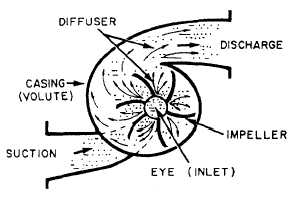the outer hub of the impeller and that part of
the pump casing in which the hub rotates. The
purpose of this is to minimize leakage from the
discharge side of the pump casing to the suction
side.
Because of the high rotational speed of the
impeller and the necessarily close clearance, the
rubbing surfaces of both the impeller hub and the
casing at that point are subject to stress, causing
rapid wear. To eliminate the need for replacing
an entire impeller and pump casing solely because
of wear in this location, most centrifugal pumps
are designed with replaceable casing wearing rings.
In most centrifugal pumps, the shaft is fitted
with a replaceable sleeve. The advantage of
using a sleeve is that it can be replaced more
economically than the entire shaft.
Mechanical seals and stuffing boxes are used
to seal between the shaft and the casing. Most
pumps are now furnished with mechanical seals;
mechanical seals do not result in better pump
operation; but, they do provide a better environ-
ment, keep bilges dry, and preserve the liquid
being pumped.
Seal piping (liquid seal) is installed to cool the
mechanical seal. Most pumps in saltwater service
with total head of 30 psi or more are also fitted
with cyclone separators. These separators use
centrifugal force to prevent abrasive material
(such as sand in the seawater) from passing
between the sealing surfaces of the mechanical
seal. There is an opening at each end of the
separator. The opening at the top is for “clean”
water, which is directed though tubing to the
mechanical seals in the pump. The high-velocity
“dirty” water is directed through the bottom of
the separator, back to the inlet piping for the
pump.
Figure 9-3.—Centrifugal pump flow.
Bearings support the weight of the impeller
and shaft and maintain the position of the
impeller—both radially and axially. Some bearings
are grease-lubricated with grease cups to allow for
periodic relubrication.
The power end of the centrifugal pump you
are to work with has an electric motor that is
maintained by your ship’s Electrician’s Mate.
OPERATION.— Liquid enters the rotating
impeller on the suction side of the casing and
enters the eye of the impeller (fig. 9-3). Liquid
is thrown out through the opening around the
edge of the impeller and against the side of the
casing by centrifugal force. This is where the
pump got its name. When liquid is thrown out
to the edge of the casing, a region of low pressure
(below atmospheric) is created around the center
of the impeller; more liquid moves into the eye
to replace the liquid that was thrown out. Liquid
moves into the center of the impeller with a high
velocity (speed). Therefore, liquid in the center
of the impeller has a low pressure, but it is
moving at a high velocity.
Liquid moving between the blades of the
impeller spreads out, which causes the liquid to
slow down. (Its velocity decreases.) At the same
time, as the liquid moves closer to the edge of the
casing, the pressure of the liquid increases. This
change (from low pressure and high velocity at
the center to high pressure and low velocity at the
edge) is caused by the shape of the opening
between the impeller blades. This space has the
shape of a diffuser, a device that causes the
velocity-pressure relationship of any fluid that
moves through it to change.
A centrifugal pump is considered to be a
nonpositive-displacement pump because the
volume of liquid discharged from the pump
changes whenever the pressure head changes. The
pressure head is the combined effect of liquid
weight, fluid friction, and obstruction to flow. In
a centrifugal pump, the force of the discharge
pressure of the pump must be able to overcome
the force of the pressure head; otherwise, the
pump could not deliver any liquid to a piping
system. The pressure head and the discharge
pressure of a centrifugal pump oppose each other.
When the pressure head increases, the discharge
pressure of the pump must also increase. Since
no energy can be lost, when the discharge pressure
of the pump increases, the velocity of flow must
decrease. On the other hand, when the pressure
head decreases, the volume of liquid discharged
from the pump increases. As a general rule, a
9-3


